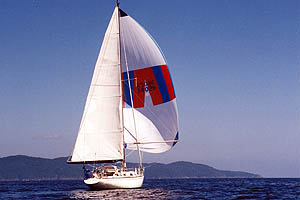
Rain in Johnstone Straight
Big blue skies, gentle seas, and a warm fair breeze! For what more could the aspiring sailor ask? We’ve been enjoying perfect conditions since leaving Vancouver on a ten day learn to cruise adventure to Port Hardy, the first leg on a 700 mile circumnavigation of Vancouver Island. On board lazing in the heat of the cockpit my two students Bob and Patrick are leisurely picking their way through the remains of a late lunch. But bit by bit the wind is dying and as the boat speed tails off to a crawl we search the horizon for signs of what the weather has next in store for us.
“Let’s take the spinnaker down.” The huge multi coloured parachute like sail has been driving our sailboat Agua Verde north-westwards on a nautical sleigh ride up Johnstone Straight. Pender Harbour, Desolation Sound and Campbell River lie in our wake. Two miles to port across a deep blue-black sparkling sea is Robson Bight, meeting place of the local killer whale population and a world heritage site. Off our starboard bow five miles ahead is the entrance to Blackfish Sound and a myriad of islands in the Broughton Archipelago. The day’s destination is the abandoned village of Mamallillacula former home of the Kwakwaka’wakw people.
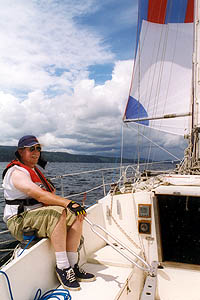 “Bob you take the helm. Patrick come up on the foredeck with me and gather in the spinnaker as I lower it.” “Aye aye”, he laughs as the descending mass of red white and blue flimsy envelops him amid much flapping of arms and howls of mock protest. No sooner is the sail thrust below decks and the debris from lunch put away than we’re hit by a blast from dead ahead. The wind has turned around 180 degrees and is starting to blow up hard. “Bob you take the helm. Patrick come up on the foredeck with me and gather in the spinnaker as I lower it.” “Aye aye”, he laughs as the descending mass of red white and blue flimsy envelops him amid much flapping of arms and howls of mock protest. No sooner is the sail thrust below decks and the debris from lunch put away than we’re hit by a blast from dead ahead. The wind has turned around 180 degrees and is starting to blow up hard.
“Wow!” says Bob as the boat heels over, accelerates quickly, and takes off across the channel seemingly on an urgent mission of its own. Bob clings to the tiller, legs outstretched across the cockpit, scrambling for balance in a world that appears to have moved 45 degrees on its side.
Sheets of spray from our bow take flight downwind, spectacularly white and sparkly against the now darkening mass of increasingly turbulent Johnstone Straight. Agua Verde surges forward like a runaway steam train with the throttle stuck open, demonstrating her offshore racing pedigree as she slices through the building waves.
Bob’s face radiates a mix of apprehension and exhilaration as he hauls hard on the tiller with both hands to keep his charge running straight. Patrick, wedged soundly on the high side of the cockpit is sporting a grin from ear to ear. The crew is clearly enjoying the moment, but the boat is overpowered and we have to do something about it. “OK folks, time to reduce sail.” Bob eases off the helm, the bow rounds up into the wind, the speed falls off. After 5 minutes of methodically taming a couple of hundred square feet of unruly mainsail, two reefs are tied in and we’re off again. With the sail area thus diminished the pace feels more sedate and the steering now light to the touch.
“Next task is to set a headsail forward of the mast to balance the rig.” Clipping a safety harness onto a lifeline that runs the length of the vessel I drag the staysail behind me in its bright blue nylon bag. Bracing my sea boots against the toerail as the foaming sea rushes by inches below, I edge my way forward at a deliberate pace and settle securely on the now plunging foredeck. The heavy weather sail is fastened onto the inner stay, the sheets and halyard secured, and we’re set to hoist.
“Get ready to trim the sail” I holler, the wind now over 20 knots, and the background noise of a boat at sea already necessitating an extra effort to communicate. I haul on the braided rope halyard and the staysail rises out of its bag like an angry venomous snake snapping and biting in all directions as it climbs to its appointed position on the dark alloy mast 30 feet overhead. The flailing sail cracks like gunfire before being progressively brought under control. Patrick in the cockpit is hunched, 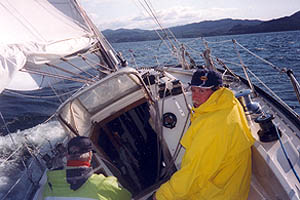 seemingly headless, over a winch, grinding for all he’s worth, his task to transform this raw energy into a useful ally, a key ingredient in the aero and hydrodynamic equation that will enable us to sail into the wind and onwards to our destination. seemingly headless, over a winch, grinding for all he’s worth, his task to transform this raw energy into a useful ally, a key ingredient in the aero and hydrodynamic equation that will enable us to sail into the wind and onwards to our destination.
Astern our lovely blue sky is receding in the distance. Above it’s overcast and dull, but ahead a solid grey-black amorphous wall of cloud is tumbling downwind to meet us. “I’ll steer for a bit, better get below and put some oilskins on.” Within minutes we plunge into the gloomy half light of the fast moving front and are lashed by a downpour of tropical intensity. Rain is bouncing 6 inches off the deck and creating a maelstrom of bubbles us as it endeavours to pound the rude waves into submission. The boat charges ahead like a thoroughbred at a steady 20 degree angle of heel, now nicely balanced under reduced sail and savouring the conditions for which she was designed. Bob having resumed his turn on the helm, one eye squinting at an angle out of a tightly drawn yellow hood, maintains a close hauled course up the straight. Even as the rain stings what little of our faces remains exposed we stay snug and comfortable in our foul weather gear, adrenalin pumping through our veins. Nothing is said but as we exchange glances the gleam of light in our eyes conveys among us a glorious feeling of shared well-being and excitement.
For 90 minutes we drive on, tacking back and forth up the channel, the rain unabated, the wind gusting over 25 knots. Visibility at a mile is still good enough for us to pick out the northern tip of West Cracroft Island shrouded in a typical west coast haze. Its scraggy stunted trees form a vanguard of pines, stark and black on its rocky headland, against a slate grey sky. The sea has built up considerably, and every fifth or sixth wave now sends a sheet of spray from the bows flying backwards towards us. Everyone by now is ducking instinctively. Occasionally we get partially caught with our heads up and the spray trickling down our faces leaves a not unpleasant salty taste on the lips. Combined with the seaweed scent of the ocean and the sweet fragrance from a billion evergreen needles miles to windward, the adventurer is offered a heady mix for the senses.
“Steer 020 degrees, true north. We’ll go through Whitebeach Pass”. Clearing the headland we pick our way through the tidal rips of Blackney Passage leaving the exposed reef off Parson Island well to starboard as we enter Blackfish Sound. Such potential dangers to leeward must necessarily rank high in the mariner’s consciousness as he plots a course to a safe haven. By now the teamwork we have developed over five days ensures that the three of us each perform our appointed tasks with an economy of effort. Reference is continually made to the chart below, landmarks identified, and bearings confirmed.
The bigger waves of Johnston Straight have given way to a steep chop in the Sound and Agua Verde is now central in a ring of broken islands whose 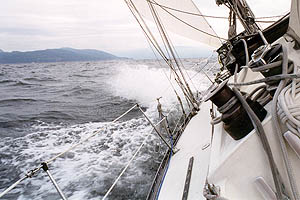 radius extends a thousand yards or more. The wind too has eased slightly, the rain still heavy. Ahead the islands seem to blend one into the other, a blurry black jagged ribbon separating sea from sky. Leaden clouds race close overhead on their busy way to who knows where, the waters dark and mysterious below an ever changing surface. radius extends a thousand yards or more. The wind too has eased slightly, the rain still heavy. Ahead the islands seem to blend one into the other, a blurry black jagged ribbon separating sea from sky. Leaden clouds race close overhead on their busy way to who knows where, the waters dark and mysterious below an ever changing surface.
“I can’t see the gap!” Patrick at the tiller is straining his eyes ahead as we rush towards what appears to be an unbroken heavily treed shoreline about 500 yards off. His brow is furrowed and a look of concern has now replaced the cheery confidence of the last few hours. “You’re right on target. Just hold her steady and you’ll see the entrance shortly”. Another gust catches us and the charging boat heels over further. Pat, knuckles now white on the tiller, is clearly giving the conduct of the vessel his fullest attention. “You’re doing fine; almost there”. A tiny patch of white sand beach becomes visible out of the bottle green screen of trees. Two hundred yards ahead this pristine strip of sand now stands out prominently, a beacon marking a hidden channel that is the portal to the security of our planned anchorage.
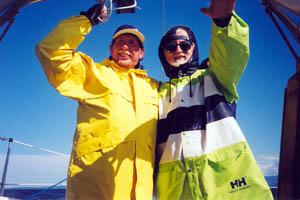 The grin on the helmsman’s face returns, the shoulders come down, and the tensions of handling a small boat in breezy conditions evaporate as he points us with regained composure into the narrow aperture. As we ghost along, sheltered from the wind in the now smooth tar black water, the trees rise a hundred feet and more only 20 yards on either side. Clumps of stringy lichens hang from the lower branches above vivid patches of lush mosses. The irregular path of the rocky shore is strewn with glistening golden-brown kelp and the battered flotsam of a coastal rain forest. The contrast in conditions is profound as is the change in emotions. Absent is the buffeting of the waves, the constant press of the wind on ones cheek, and the ongoing commitment to balance. Gone too is the vigilance and exhilaration of a heightened state of alert. In its place a sense of calm pervades, the quiet glow of accomplishment, and the reward of earned relaxation created by the juxtaposition of stress and relief. The grin on the helmsman’s face returns, the shoulders come down, and the tensions of handling a small boat in breezy conditions evaporate as he points us with regained composure into the narrow aperture. As we ghost along, sheltered from the wind in the now smooth tar black water, the trees rise a hundred feet and more only 20 yards on either side. Clumps of stringy lichens hang from the lower branches above vivid patches of lush mosses. The irregular path of the rocky shore is strewn with glistening golden-brown kelp and the battered flotsam of a coastal rain forest. The contrast in conditions is profound as is the change in emotions. Absent is the buffeting of the waves, the constant press of the wind on ones cheek, and the ongoing commitment to balance. Gone too is the vigilance and exhilaration of a heightened state of alert. In its place a sense of calm pervades, the quiet glow of accomplishment, and the reward of earned relaxation created by the juxtaposition of stress and relief.
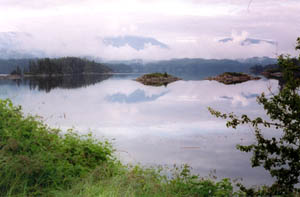
Forty five minutes later the chain rattles noisily over the bow roller as the anchor finds bottom on the shallows off the crushed shell beach of picturesque Mamallillacula. Under a clearing sky Agua Verde gently falls off a little then is brought head to wind as the ground tackle digs in. Ashore the massive gable timbers of a once proud ancient long house look out over us to seaward. It’s a special place. The boat comes to rest and so do we.
CTC
Bewley Sailing
|


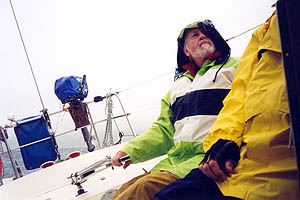
 radius extends a thousand yards or more. The wind too has eased slightly, the rain still heavy. Ahead the islands seem to blend one into the other, a blurry black jagged ribbon separating sea from sky. Leaden clouds race close overhead on their busy way to who knows where, the waters dark and mysterious below an ever changing surface.
radius extends a thousand yards or more. The wind too has eased slightly, the rain still heavy. Ahead the islands seem to blend one into the other, a blurry black jagged ribbon separating sea from sky. Leaden clouds race close overhead on their busy way to who knows where, the waters dark and mysterious below an ever changing surface. The grin on the helmsman’s face returns, the shoulders come down, and the tensions of handling a small boat in breezy conditions evaporate as he points us with regained composure into the narrow aperture. As we ghost along, sheltered from the wind in the now smooth tar black water, the trees rise a hundred feet and more only 20 yards on either side. Clumps of stringy lichens hang from the lower branches above vivid patches of lush mosses. The irregular path of the rocky shore is strewn with glistening golden-brown kelp and the battered flotsam of a coastal rain forest. The contrast in conditions is profound as is the change in emotions. Absent is the buffeting of the waves, the constant press of the wind on ones cheek, and the ongoing commitment to balance. Gone too is the vigilance and exhilaration of a heightened state of alert. In its place a sense of calm pervades, the quiet glow of accomplishment, and the reward of earned relaxation created by the juxtaposition of stress and relief.
The grin on the helmsman’s face returns, the shoulders come down, and the tensions of handling a small boat in breezy conditions evaporate as he points us with regained composure into the narrow aperture. As we ghost along, sheltered from the wind in the now smooth tar black water, the trees rise a hundred feet and more only 20 yards on either side. Clumps of stringy lichens hang from the lower branches above vivid patches of lush mosses. The irregular path of the rocky shore is strewn with glistening golden-brown kelp and the battered flotsam of a coastal rain forest. The contrast in conditions is profound as is the change in emotions. Absent is the buffeting of the waves, the constant press of the wind on ones cheek, and the ongoing commitment to balance. Gone too is the vigilance and exhilaration of a heightened state of alert. In its place a sense of calm pervades, the quiet glow of accomplishment, and the reward of earned relaxation created by the juxtaposition of stress and relief.